Setting goals is an integral part of personal and academic growth. For students, adopting the SMART goals framework provides a structured approach to goal-setting, fostering clarity and achievement. In this guide, we'll explore the essence of SMART goals, understand their significance for students, and delve into practical examples and strategies to empower students on their journey to success.
What Are SMART Goals
SMART goals stand for specific, measurable, achievable, relevant, and time-bound and are a systematic approach to goal-setting. Specificity provides clarity, measurability tracks progress, achievability ensures feasibility, relevance aligns goals with broader objectives, and timeliness sets deadlines. This section is the cornerstone of understanding SMART goals and provides a solid foundation for effective and purposeful goal setting.
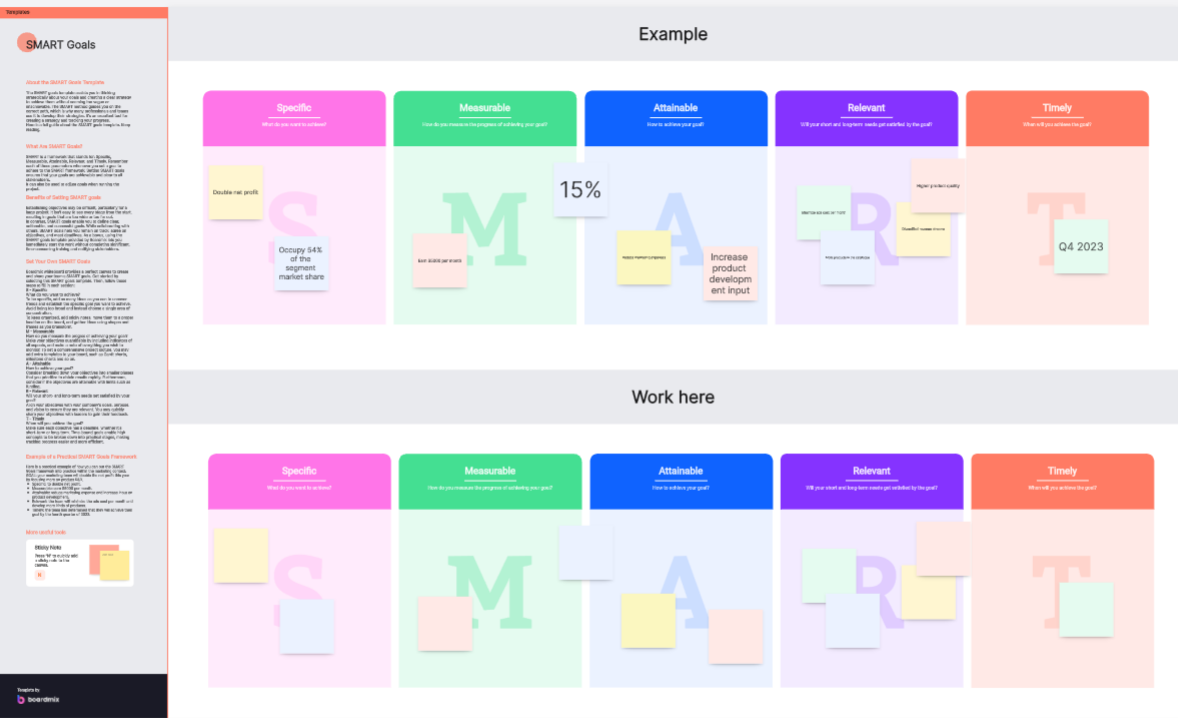
In essence, SMART goals provide a strategic framework that enables individuals to effectively articulate, measure, and achieve goals. The breakdown of the elements in SMART provides a clear roadmap to ensure that goals are well-defined, progress is measurable, feasibility is realistic, alignment with broader goals, and a sense of urgency is maintained with deadlines. This foundational understanding is critical and sets the stage for individuals to embark on a journey to achieve their desired goals.
Why Set SMART Goals for Students
Setting SMART goals is vital for students, shaping their academic and personal growth. This deliberate approach fosters focus, motivation, and a tangible sense of accomplishment. The following details underscore the profound impact SMART goals have on enhancing students' overall success.
Enhanced Focus: SMART goals provide students with a specific target, reducing distractions and promoting concentrated efforts toward achievement.
Heightened Motivation: The clarity of SMART goals instills a sense of purpose, motivating students to persevere through challenges and setbacks.
Tangible Accomplishments: Achieving SMART goals generates a measurable sense of success, boosting confidence and encouraging further pursuit of objectives.
Clear Roadmap: SMART goals act as a roadmap, offering a structured path that aids in effective planning and implementation of steps toward success.
Improved Time Management: The time-bound aspect of SMART goals compels students to manage their time efficiently, fostering a disciplined approach to tasks and deadlines.
Refined Decision-Making Skills: The process of setting SMART goals requires thoughtful consideration and planning, honing students' decision-making abilities for both short-term tasks and long-term aspirations.
Holistic Impact: SMART goals contribute to a holistic student experience, integrating academic, personal, and extracurricular pursuits into a cohesive framework for success.
In essence, the deliberate adoption of SMART goals transforms the student experience by providing a structured, motivational framework that not only enhances academic performance but also cultivates crucial life skills. This section sheds light on the multifaceted impact of SMART goals, emphasizing their role in shaping well-rounded and successful students.
5 Long-term SMART Goals Examples for Students
Long-term SMART goals serve as guiding beacons for students, shaping their academic journey and personal development. These goals, rooted in Specific, Measurable, Achievable, Relevant, and Time-bound criteria, provide a strategic framework for sustained achievement. In this section, we will explore five exemplary long-term SMART goals, breaking down each with step-by-step details to empower students in realizing their aspirations.
SMART Goals Example For Students-01: Academic Excellence
Establishing a Specific GPA Target
- Specific Goal: Define a precise GPA target, such as achieving a 3.8 by the end of the academic year.
- Measurable Criteria: Break down the GPA into individual course targets for clear measurement.
- Achievability Assessment: Evaluate current performance and set incremental goals for improvement.
- Relevance: Align the GPA target with broader academic and career aspirations.
- Time-bound: Establish milestones for GPA improvements throughout the academic year.
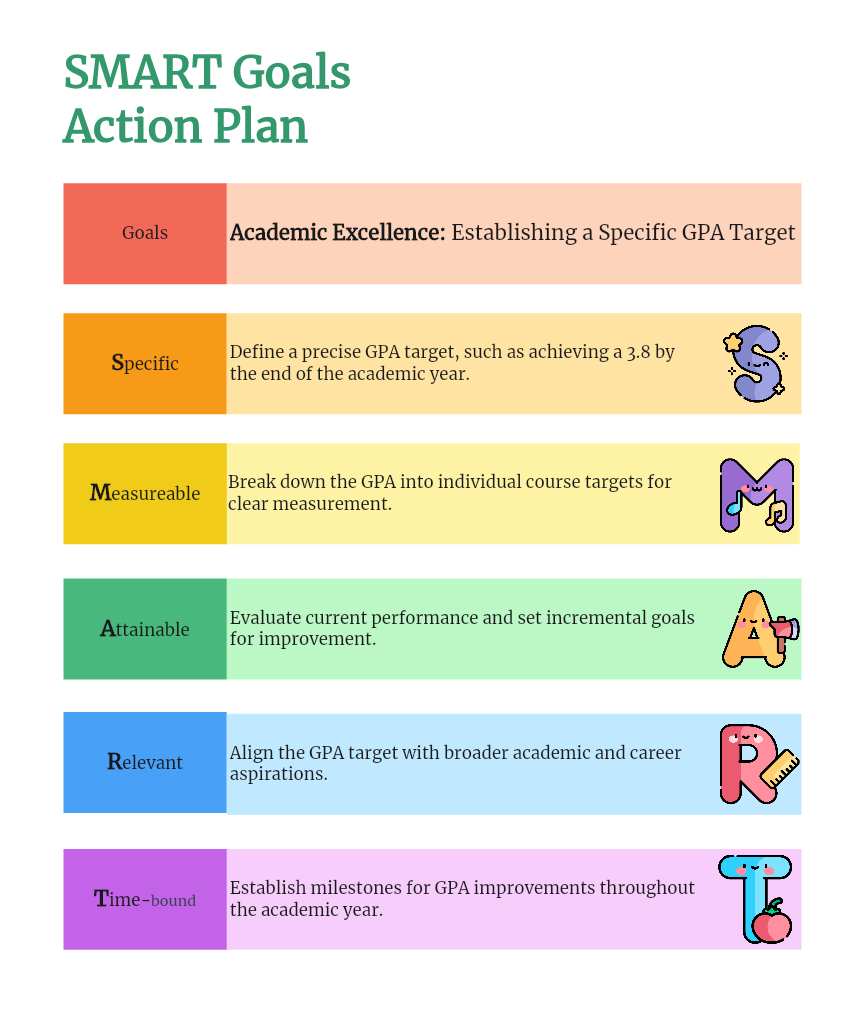
SMART Goals Example For Students - 02: Skill Mastery
Developing a Comprehensive Plan for a New Skill
- Specific Goal: Identify a specific skill to master, like coding or public speaking.
- Measurable Criteria: Break down the skill into manageable components for progress tracking.
- Achievability Assessment: Assess current skill level and set realistic improvement benchmarks.
- Relevance: Connect skill acquisition with academic and personal development goals.
- Time-bound: Create a timeline with milestones for skill acquisition and application.
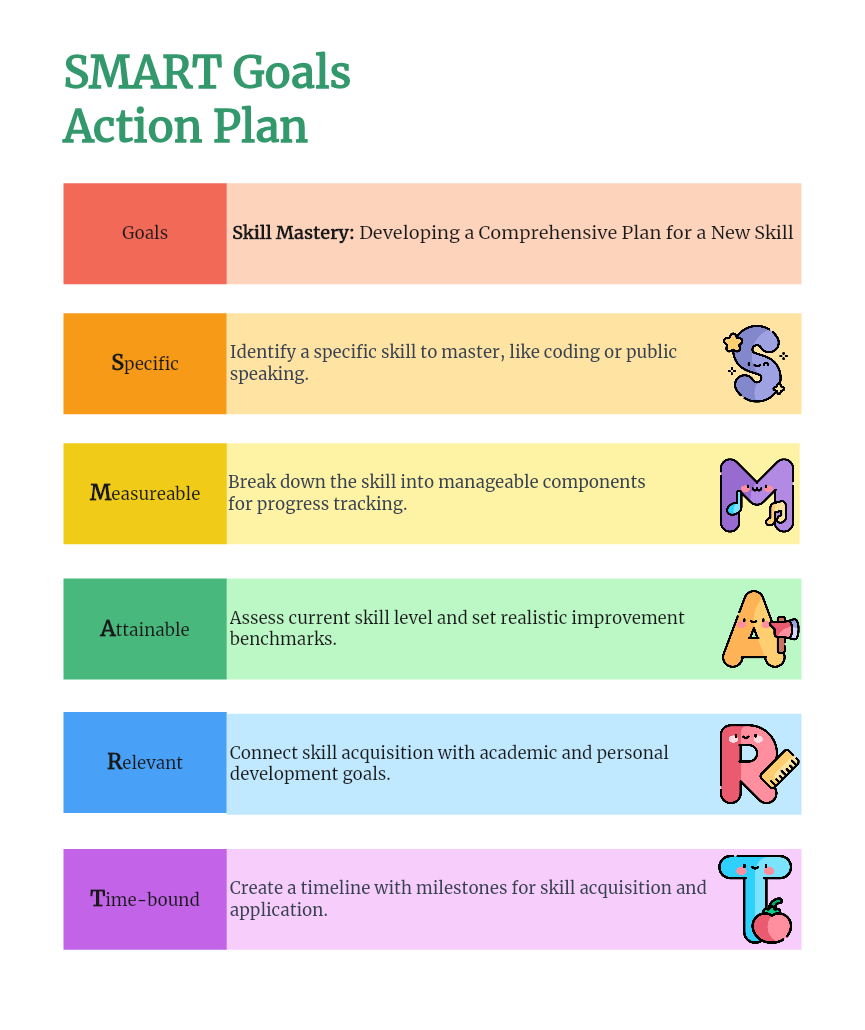
SMART Goals Example For Students - 03: Leadership Development
Outlining Steps for a Student Organization Role
- Specific Goal: Identify a leadership role in a student organization.
- Measurable Criteria: Break down leadership skills needed and track progress in acquiring them.
- Achievability Assessment: Evaluate current leadership abilities and set realistic development goals.
- Relevance: Connect leadership development with personal and career growth.
- Time-bound: Establish deadlines for assuming the leadership role and achieving leadership milestones.

SMART Goals Example for Students - 04: Community Involvement
Designing a Positive Impact Project
- Specific Goal: Define a community project to positively contribute.
- Measurable Criteria: Break down project tasks for measurable progress.
- Achievability Assessment: Evaluate resources and capabilities for successful project completion.
- Relevance: Align the project with personal values and community needs.
- Time-bound: Set project milestones and completion deadlines.
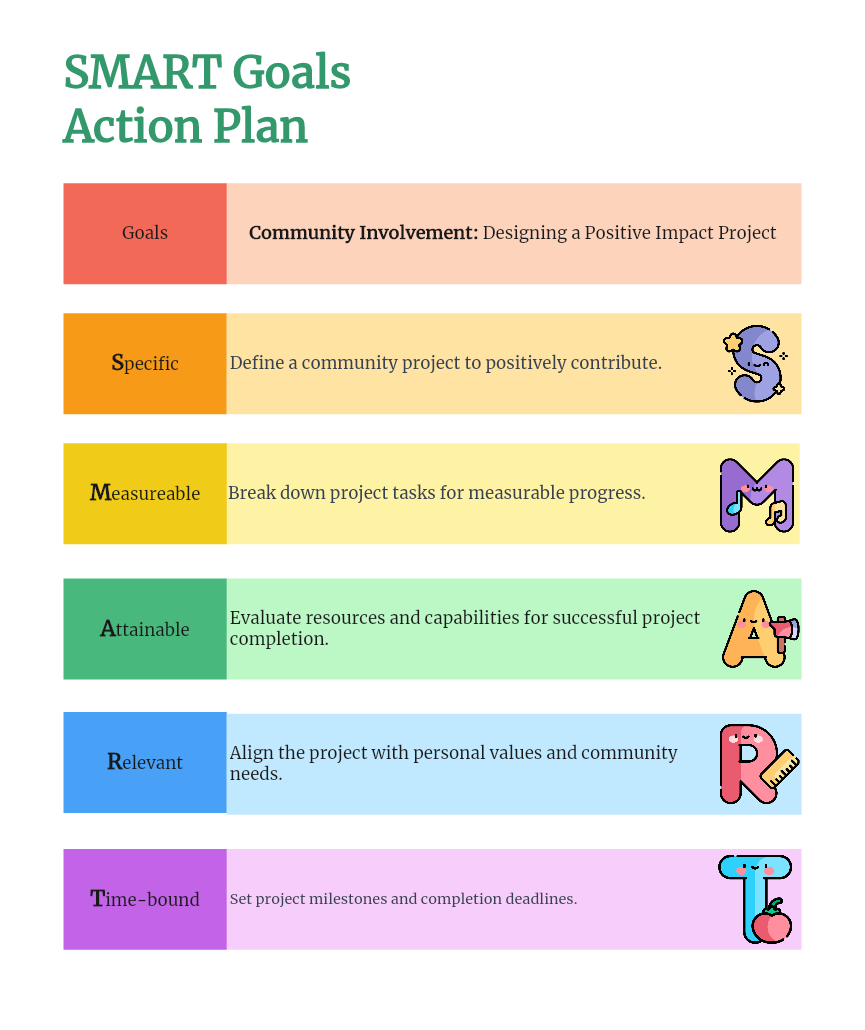
SMART Goals Example for Students - 05: Career Aspirations
Creating a Roadmap for Long-Term Goals
- Specific Goal: Clearly outline long-term career aspirations.
- Measurable Criteria: Break down career milestones and achievements for measurable progress.
- Achievability Assessment: Assess current skills and qualifications against career requirements.
- Relevance: Align career goals with personal strengths and interests.
- Time-bound: Establish timelines for short-term career objectives leading to long-term aspirations.
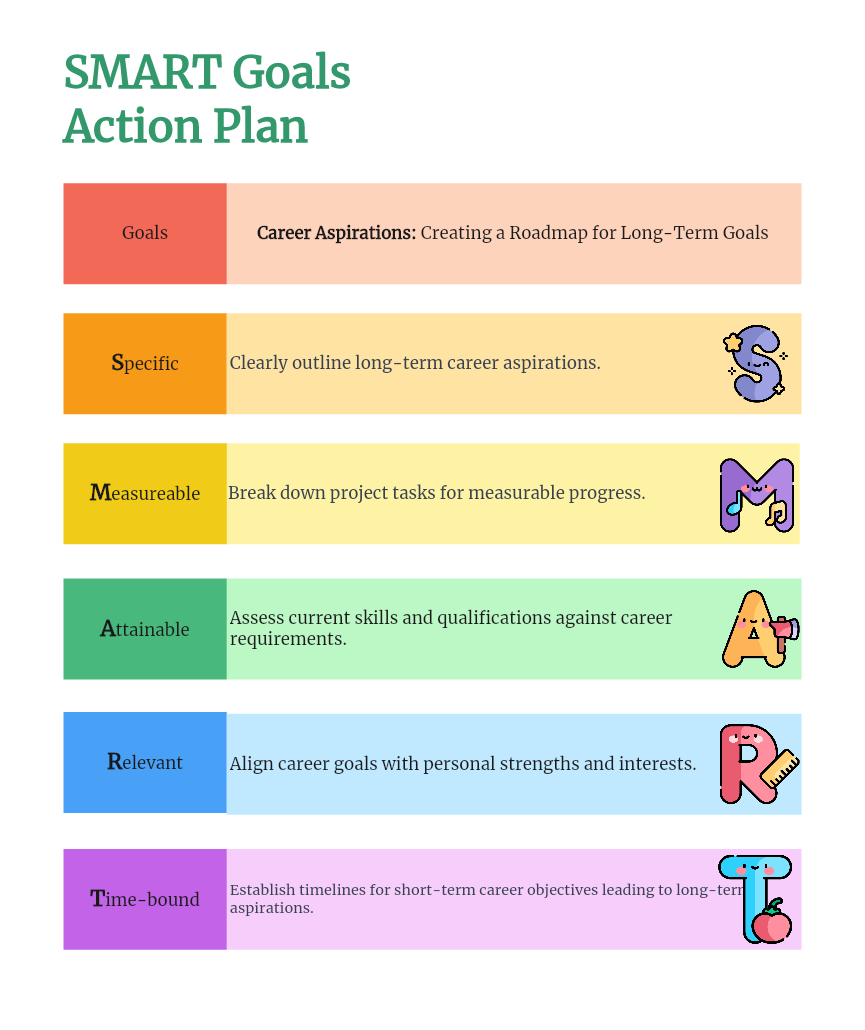
Setting long-term SMART goals equips students with a proactive approach to their future, instilling discipline, focus, and a roadmap for sustained success. These goals, whether academic, skill-based, leadership-oriented, community-focused, or career-driven, empower students to navigate their educational journey with purpose and resilience. As students diligently pursue and achieve these goals, they not only shape their academic experience but also cultivate essential life skills essential for a thriving future.
5 Short-term SMART Goals Examples for Students
Short-term SMART goals are the compass guiding students through immediate challenges and opportunities. These goals, defined by Specific, Measurable, Achievable, Relevant, and Time-bound criteria, foster a dynamic approach to learning and personal growth. In this section, we will unravel the intricacies of five short-term SMART goals, offering step-by-step guidance to empower students in their day-to-day endeavors.
SMART Goals Example For Students - 01: Weekly Study Targets
Setting Specific Study Hours
- Specific Goal: Define a set number of study hours for each week.
- Measurable Criteria: Quantify study hours to track adherence and progress.
- Achievability Assessment: Align study targets with other commitments for realistic goals.
- Relevance: Connect study hours with academic goals and performance improvement.
- Time-bound: Establish a weekly schedule with dedicated study time.
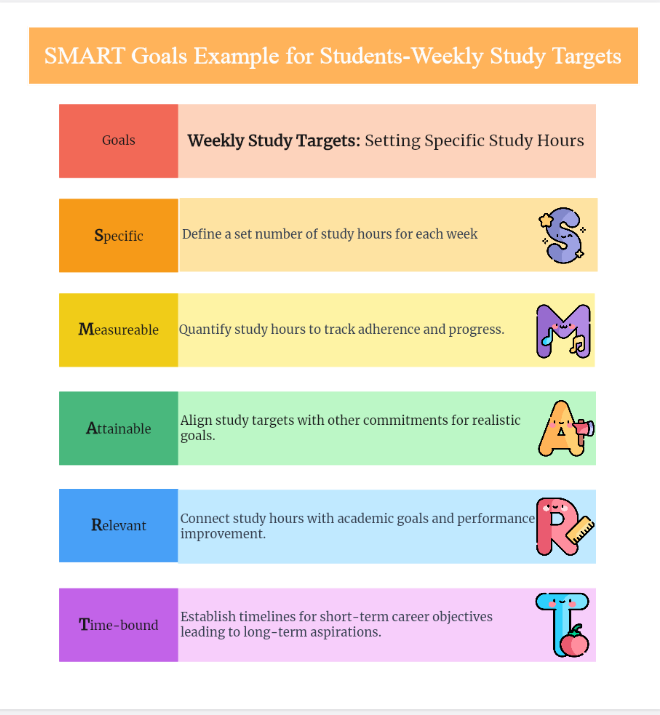
SMART Goals Example for Students - 02: Skill Building Tasks
Breaking Down Skill Development
- Specific Goal: Identify a skill to develop, such as coding or language proficiency.
- Measurable Criteria: Break down the skill into smaller, manageable tasks.
- Achievability Assessment: Assess current skill level and set realistic improvement benchmarks.
- Relevance: Connect skill development with personal and academic objectives.
- Time-bound: Assign deadlines to individual tasks for consistent progress.
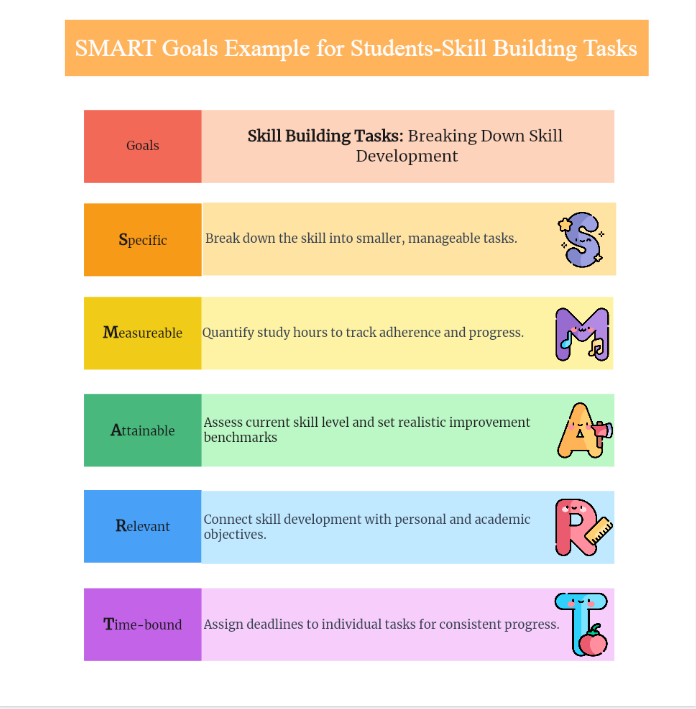
SMART Goals Example For Students - 03: Networking Events
Planning Specific Social Connections
- Specific Goal: Identify networking events or activities to attend.
- Measurable Criteria: Set a target number of new connections to make.
- Achievability Assessment: Consider available networking opportunities and align them with personal goals.
- Relevance: Connect networking with academic and career aspirations.
- Time-bound: Schedule specific events in a given timeframe.
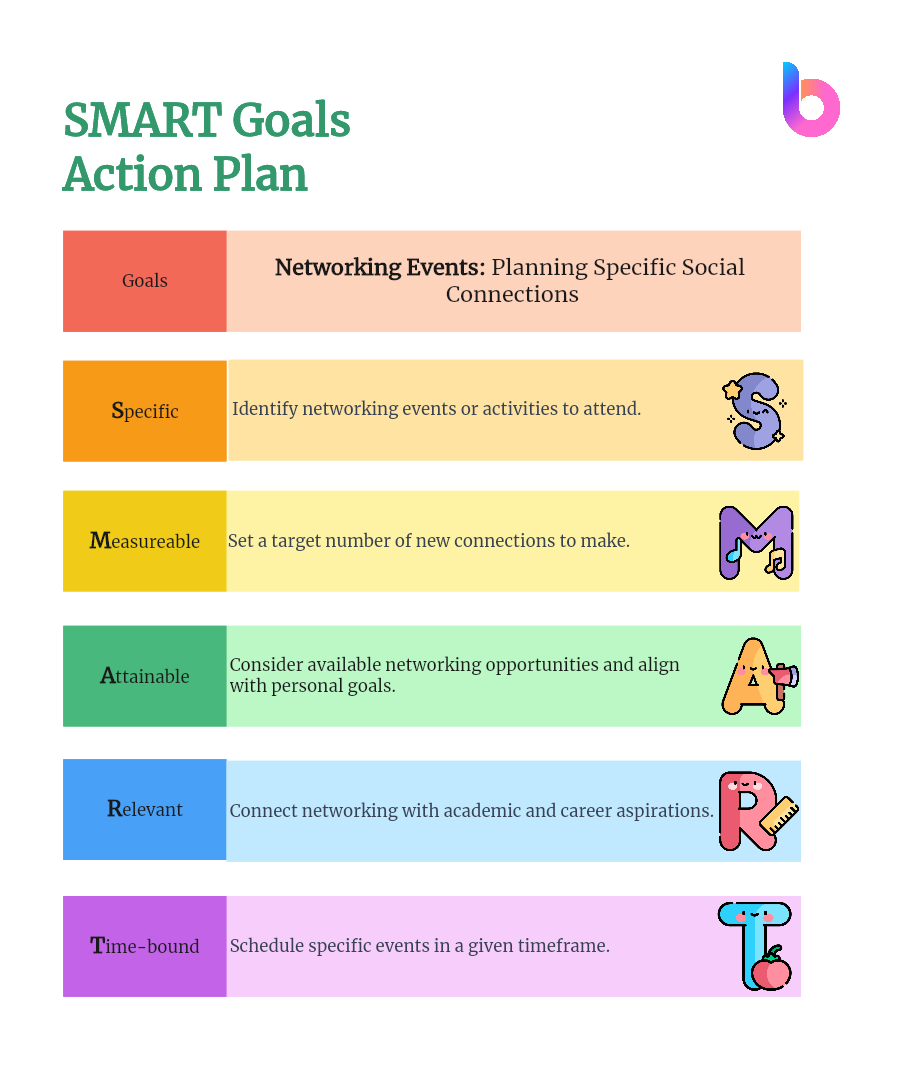
SMART Goals Example for Students - 04: Volunteer Commitments
Outlining Measurable Volunteering Goals
- Specific Goal: Define short-term volunteering objectives.
- Measurable Criteria: Break down volunteer tasks for measurable outcomes.
- Achievability Assessment: Consider time constraints and available volunteer opportunities.
- Relevance: Align volunteer goals with personal values and community impact.
- Time-bound: Set specific dates or timelines for each volunteering commitment.
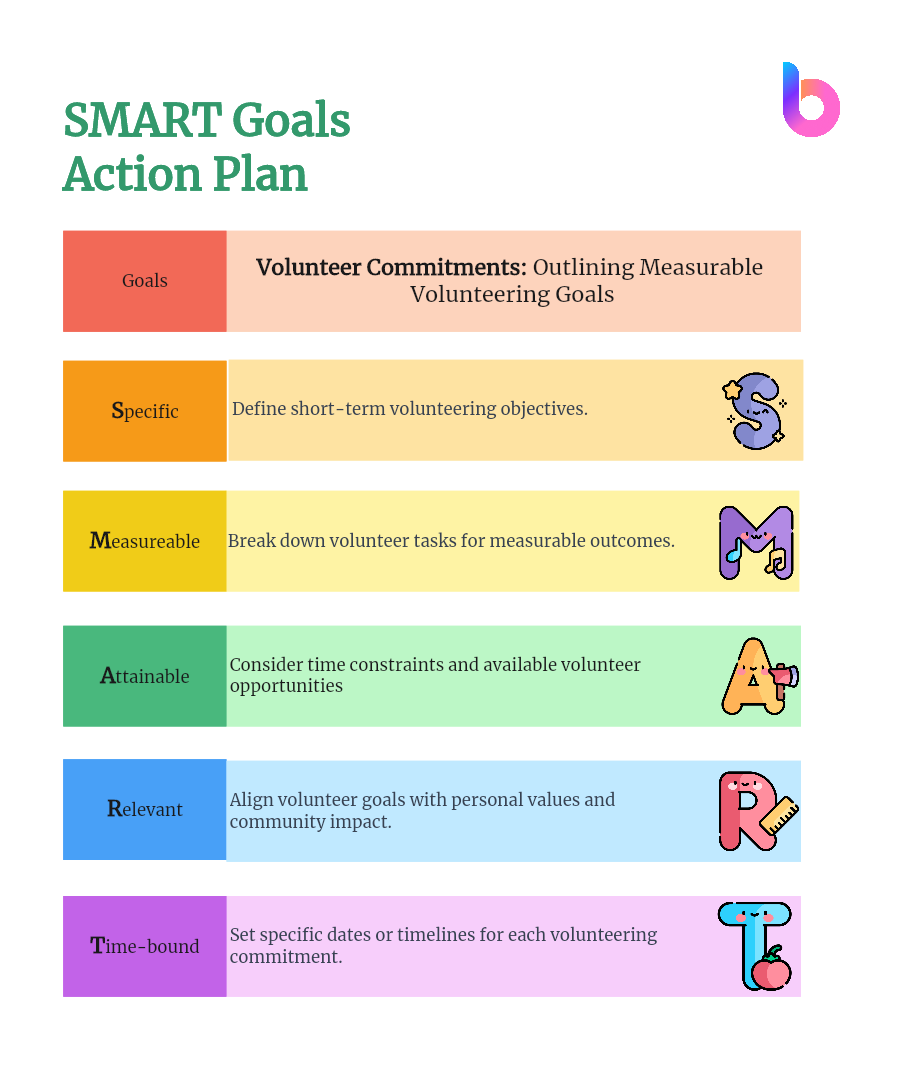
SMART Goals Example for Students - 05: Project Milestones
Breaking Down Achievable Project Steps
- Specific Goal: Define a larger project into smaller, achievable milestones.
- Measurable Criteria: Break down project tasks for measurable progress.
- Achievability Assessment: Assess resources and capabilities for successful project completion.
- Relevance: Connect project milestones with academic or personal project goals.
- Time-bound: Set deadlines for each project milestone.
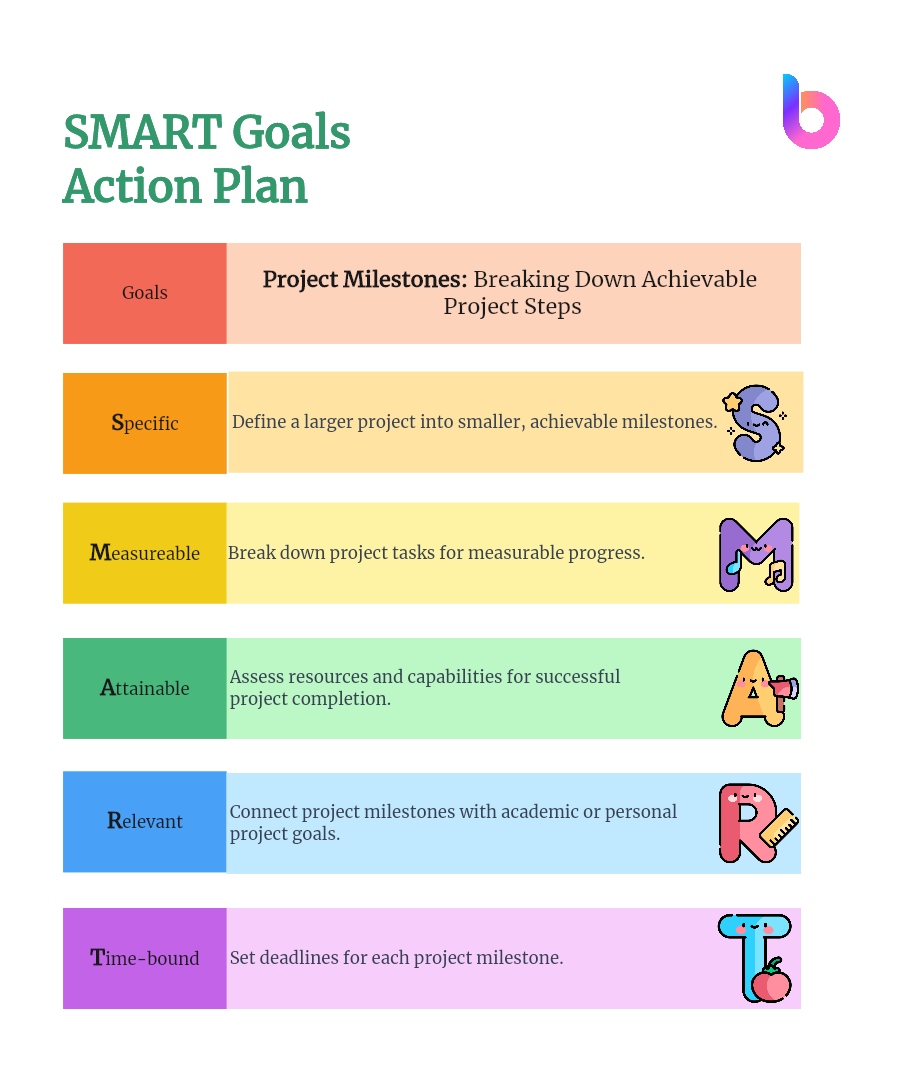
Incorporating short-term SMART goals into daily routines empowers students to tackle immediate challenges systematically. As students embrace and achieve these short-term goals, they not only refine their academic prowess but also cultivate habits essential for lifelong success. Short-term SMART goals serve as stepping stones, paving the way for a journey marked by purpose, achievement, and continuous growth.
How to Create SMART Goals for Students with a Template
Empowering students to set SMART goals is essential for their academic and personal growth. Leveraging the Boardmix platform, designed for efficient collaboration and planning, we present a step-by-step guide to creating SMART goals. Boardmix's versatile features make the goal-setting process seamless, ensuring clarity and focus for student success.
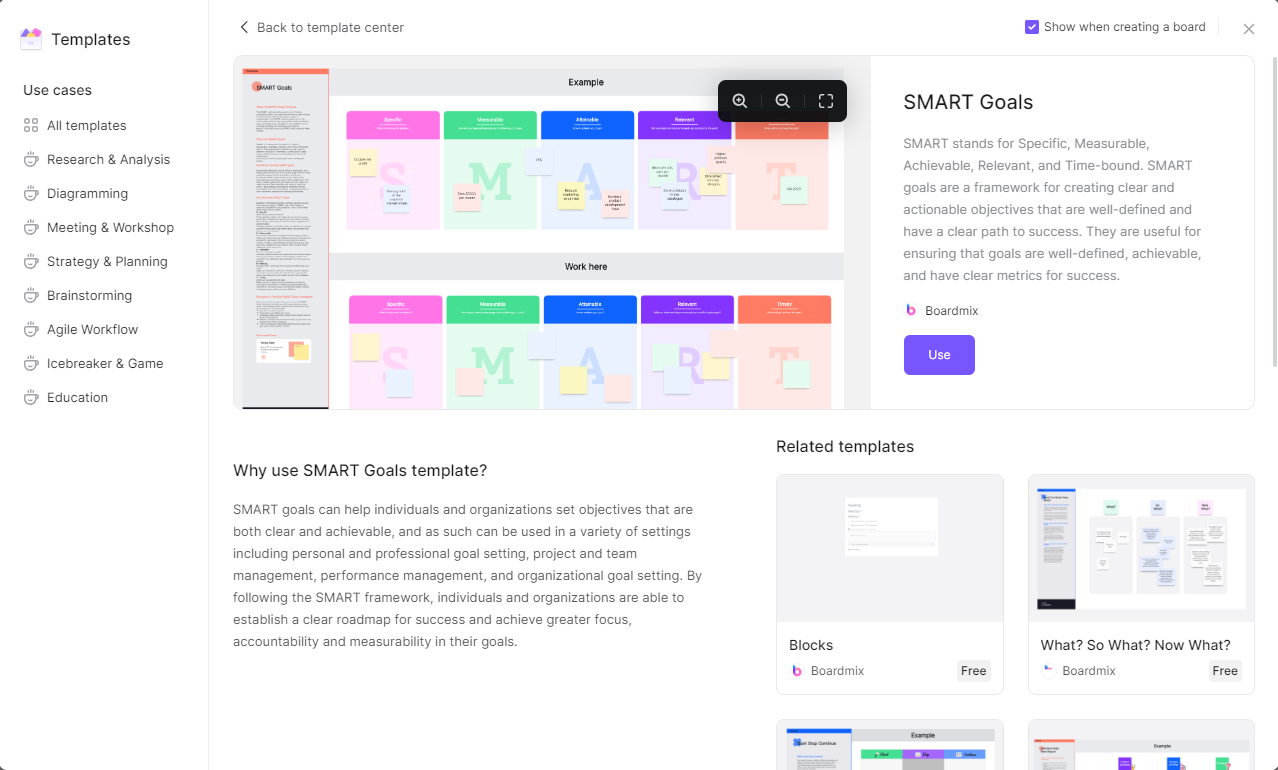
Step 1: Access Your Boardmix Account
Begin by logging into your Boardmix account using your credentials. If you're new, register to establish an account.

Step 2: Initiate a New Board
Click on the "New board" button at the top left corner of the screen. This will lead you to the editor with an infinite canvas and a range of diagramming tools.

Step 3: Designate Specific Goals with a Template
Use the canvas to clearly define your specific SMART goals. Boardmix offers a variety of templates to visually display and organize your goals.
Step 4: Break Down Goals into Measurable Elements
Utilize Boardmix's features to break down each goal into measurable criteria. Create sections or lists to quantify and track progress.
Step 5: Assess Achievability and Set Realistic Benchmarks
Leverage the versatile canvas to assess the achievability of each goal. Consider your current capabilities and resources, and set realistic improvement benchmarks.
Step 6: Share Your SMART Goals
Once your SMART goals are outlined on Boardmix, easily share the board with team members, collaborators, or stakeholders directly from the platform.

Boardmix transforms the process of creating SMART goals into a visual, collaborative, and efficient experience. By utilizing the platform's features to define, organize, and share goals, students can streamline their goal-setting journey. As students embrace SMART goal-setting with Boardmix, they gain a tangible, practical approach to personal and academic success.
Tips and Tricks on Setting SMART Goals for Students
Unlocking the full potential of SMART goal-setting involves strategic insights and expert advice. This section distills invaluable tips and tricks to optimize the process, ensuring students not only set meaningful goals but also navigate challenges with resilience.
Maintain Flexibility: Flexibility is key to adapting to unforeseen circumstances. Allow room for adjustments without compromising the overall goal.
Celebrate Milestones: Recognizing and celebrating small victories keeps motivation high. Break down larger goals into milestones, each deserving acknowledgment.
Prioritize Clarity in Goals: Ensure your goals are specific and crystal clear. Ambiguity can lead to confusion and hinder progress.
Regularly Review and Refine: Set aside time for periodic reviews. Evaluate progress, refine strategies, and adjust goals based on evolving circumstances.
Leverage Accountability Partners: Share your goals with someone you trust. Having an accountability partner provides support, encouragement, and an extra layer of commitment.
Embrace the SMART Criteria: Understand and apply the SMART criteria consistently. Each element—Specific, Measurable, Achievable, Relevant, and Time-bound—plays a crucial role in goal effectiveness.
Utilize Technology for Efficiency: Leverage tools like the Boardmix platform for seamless goal tracking. Boardmix enhances organization and collaboration, ensuring goals remain visible and manageable.
Visualize Success: Create visual representations of your goals. Whether through charts, graphs, or vision boards, visualization reinforces commitment and clarity.
By integrating these tips into their goal-setting approach, students cultivate a resilient mindset and the skills needed to overcome challenges. Introducing tools like Boardmix amplifies the effectiveness of goal tracking, providing a centralized platform for clarity and collaboration. As students implement these strategies, they not only set themselves up for academic success but also nurture essential life skills that extend beyond the classroom.








